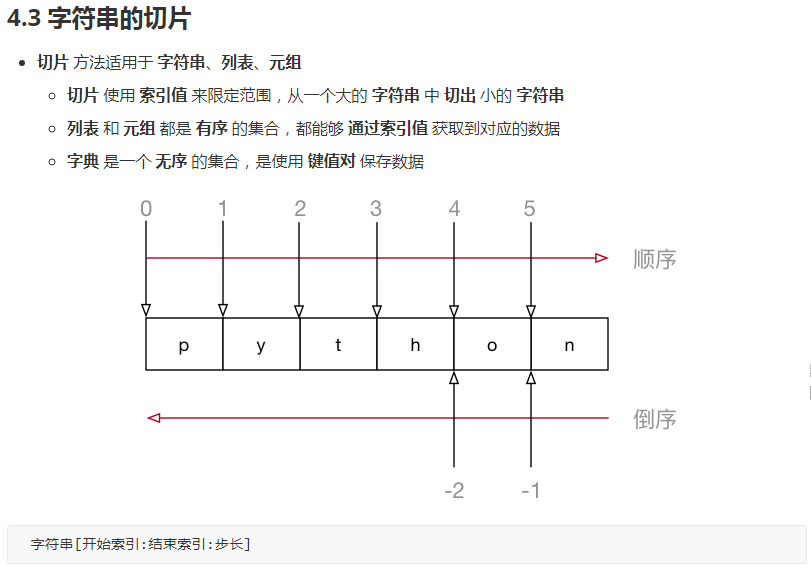20-字符串
-
字符串 就是 一串字符,是编程语言中表示文本的数据类型
-
在 Python 中可以使用 一对双引号
"或者 一对单引号'定义一个字符串-
虽然可以使用
\"或者\'做字符串的转义,但是在实际开发中:-
如果字符串内部需要使用
",可以使用'定义字符串 -
如果字符串内部需要使用
',可以使用"定义字符串
-
-
-
可以使用 索引 获取一个字符串中 指定位置的字符,索引计数从 0 开始
-
也可以使用
for循环遍历 字符串中每一个字符
大多数编程语言都是用
"
In [1]: hello_str.
hello_str.capitalize hello_str.isidentifier hello_str.rindex
hello_str.casefold hello_str.islower hello_str.rjust
hello_str.center hello_str.isnumeric hello_str.rpartition
hello_str.count hello_str.isprintable hello_str.rsplit
hello_str.encode hello_str.isspace hello_str.rstrip
hello_str.endswith hello_str.istitle hello_str.split
hello_str.expandtabs hello_str.isupper hello_str.splitlines
hello_str.find hello_str.join hello_str.startswith
hello_str.format hello_str.ljust hello_str.strip
hello_str.format_map hello_str.lower hello_str.swapcase
hello_str.index hello_str.lstrip hello_str.title
hello_str.isalnum hello_str.maketrans hello_str.translate
hello_str.isalpha hello_str.partition hello_str.upper
hello_str.isdecimal hello_str.replace hello_str.zfill
hello_str.isdigit hello_str.rfind
| 方法 | 说明 |
|---|---|
| string.isspace() | 如果 string 中只包含空格,则返回 True |
| string.isalnum() | 如果 string 至少有一个字符并且所有字符都是字母或数字则返回 True |
| string.isalpha() | 如果 string 至少有一个字符并且所有字符都是字母则返回 True |
| string.isdecimal() | 如果 string 只包含数字则返回 True,全角数字 |
| string.isdigit() | 如果 string 只包含数字则返回 True,全角数字、⑴、\u00b2 |
| string.isnumeric() | 如果 string 只包含数字则返回 True,全角数字,汉字数字 |
| string.istitle() | 如果 string 是标题化的(每个单词的首字母大写)则返回 True |
| string.islower() | 如果 string 中包含至少一个区分大小写的字符,并且所有这些(区分大小写的)字符都是小写,则返回 True |
| string.isupper() | 如果 string 中包含至少一个区分大小写的字符,并且所有这些(区分大小写的)字符都是大写,则返回 True |
| 方法 | 说明 |
|---|---|
| string.startswith(str) | 检查字符串是否是以 str 开头,是则返回 True |
| string.endswith(str) | 检查字符串是否是以 str 结束,是则返回 True |
| string.find(str, start=0, end=len(string)) | 检测 str 是否包含在 string 中,如果 start 和 end 指定范围,则检查是否包含在指定范围内,如果是返回开始的索引值,否则返回 -1 |
| string.rfind(str, start=0, end=len(string)) | 类似于 find(),不过是从右边开始查找 |
| string.index(str, start=0, end=len(string)) | 跟 find() 方法类似,不过如果 str 不在 string 会报错 |
| string.rindex(str, start=0, end=len(string)) | 类似于 index(),不过是从右边开始 |
| string.replace(old_str, new_str, num=string.count(old)) | 把 string 中的 old_str 替换成 new_str,如果 num 指定,则替换不超过 num 次 |
| 方法 | 说明 |
|---|---|
| string.capitalize() | 把字符串的第一个字符大写 |
| string.title() | 把字符串的每个单词首字母大写 |
| string.lower() | 转换 string 中所有大写字符为小写 |
| string.upper() | 转换 string 中的小写字母为大写 |
| string.swapcase() | 翻转 string 中的大小写 |
| 方法 | 说明 |
|---|---|
| string.ljust(width) | 返回一个原字符串左对齐,并使用空格填充至长度 width 的新字符串 |
| string.rjust(width) | 返回一个原字符串右对齐,并使用空格填充至长度 width 的新字符串 |
| string.center(width) | 返回一个原字符串居中,并使用空格填充至长度 width 的新字符串 |
| 方法 | 说明 |
|---|---|
| string.lstrip() | 截掉 string 左边(开始)的空白字符 |
| string.rstrip() | 截掉 string 右边(末尾)的空白字符 |
| string.strip() | 截掉 string 左右两边的空白字符 |
| 方法 | 说明 |
|---|---|
| string.partition(str) | 把字符串 string 分成一个 3 元素的元组 (str前面, str, str后面) |
| string.rpartition(str) | 类似于 partition() 方法,不过是从右边开始查找 |
| string.split(str="", num) | 以 str 为分隔符拆分 string,如果 num 有指定值,则仅分隔 num + 1 个子字符串,str 默认包含 '\r', '\t', '\n' 和空格 |
| string.splitlines() | 按照行('\r', '\n', '\r\n')分隔,返回一个包含各行作为元素的列表 |
| string.join(seq) | 以 string 作为分隔符,将 seq 中所有的元素(的字符串表示)合并为一个新的字符串 |




